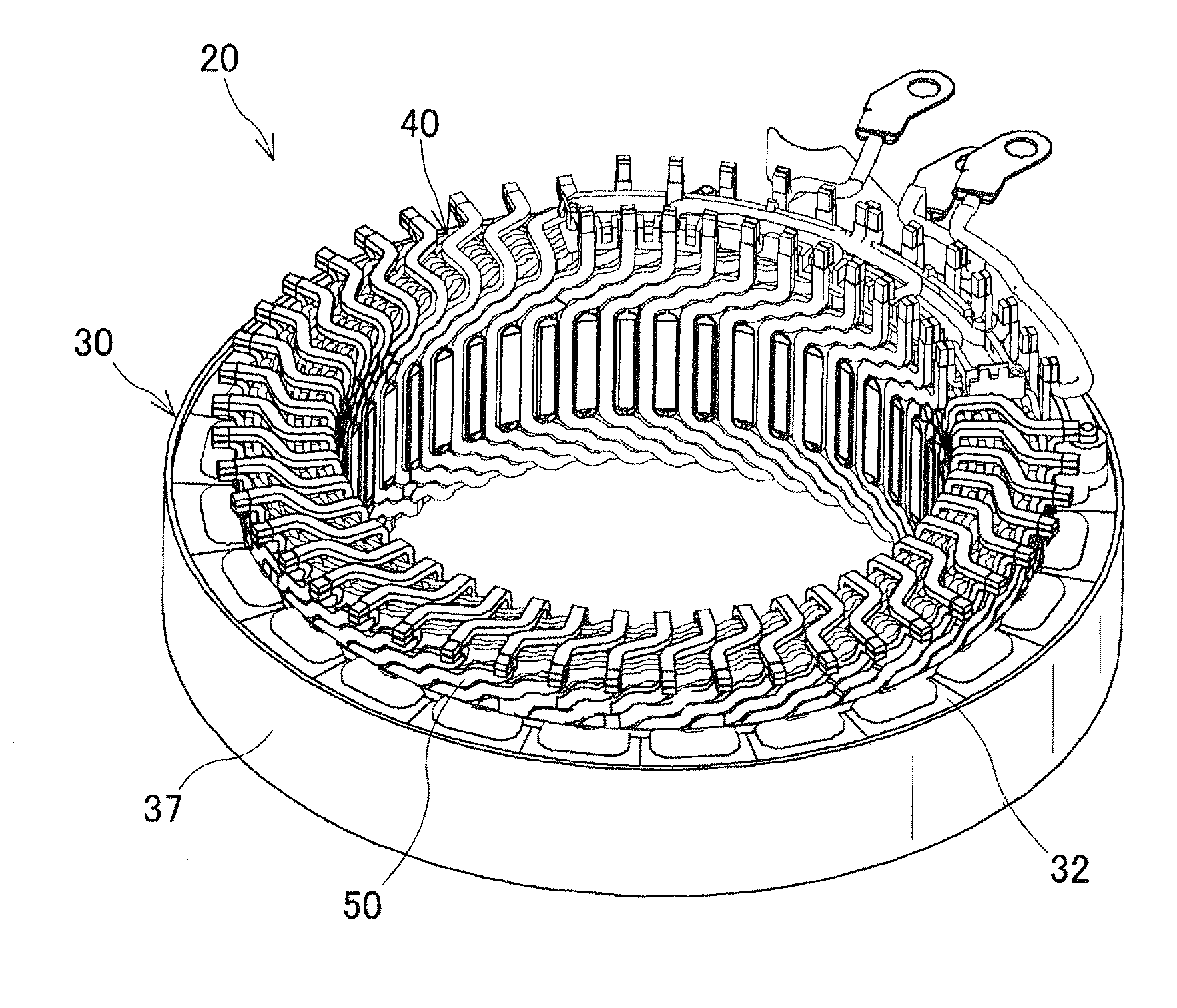Method of manufacturing stator coil for electric rotating machine
a technology of electric rotating machines and stator coils, which is applied in the manufacture of dynamo-electric machines, electrical apparatus, dynamo-electric machines, etc., can solve the problems of affecting the service life of the electric wire, the in-slot portion of the in-slot portion of the electric wire may be damaged, and the stator coil and the stator core are difficult to easily and accurately assembled, so as to prevent radial misalignment, shorten the length of each electric wir
- Summary
- Abstract
- Description
- Claims
- Application Information
AI Technical Summary
Benefits of technology
Problems solved by technology
Method used
Image
Examples
first embodiment
[0066]FIGS. 1-3 together show the overall configuration of a stator 20 which includes a three-phase stator coil 40 manufactured by a method according a first embodiment.
[0067]The stator 20 is designed to be used in, for example, an electric rotating machine (not shown) that can function both as an electric motor and as an electric generator in a motor vehicle.
[0068]In addition to the stator 20, the electric rotating machine further includes a rotor (not shown) that is rotatably disposed radially inside of the stator 20. The rotor includes a plurality of permanent magnets that form a plurality of magnetic poles on the radially outer periphery of the rotor to face the radially inner periphery of the stator 20. The magnetic poles are spaced in the circumferential direction of the rotor at predetermined intervals so that the polarities of the magnetic poles alternate between north and south in the circumferential direction. In addition, the number of the magnetic poles formed in the rot...
second embodiment
[0217]This embodiment illustrates a method of manufacturing the stator coil 40 which is similar to the method according to the first embodiment; accordingly, only the differences therebetween will be described hereinafter.
[0218]In the first embodiment, the first to the sixth positioning members 90a-90f are used in the assembly step 103. The first and second positioning members 90a and 90b are axially located on the side of the first volute jig 85A, while the third to the sixth positioning members 90c-90f are axially located on the side of the second volute jig 85B. Each of the first and second volute jigs 85A and 85B has the windows 86 formed therein. All the first to the sixth positioning members 90a-90f are configured to be radially advanced and retreated without moving in the axial direction.
[0219]In comparison, in the present embodiment, referring to FIGS. 29A-29D, only the first to the third positioning members 90a-90c are used in the assembly step 103. The first positioning me...
third embodiment
[0235]This embodiment illustrates a method of manufacturing the stator coil 40 which is similar to the method according to the first embodiment; accordingly, only the differences therebetween will be described hereinafter.
[0236]In the first embodiment, the first and second volute jigs 85A and 85B are used to respectively radially elastically deform the first and second components 61 and 62 during each of the assembly processes in the assembly step 103 (see FIGS. 22A-22B).
[0237]In comparison, in the present embodiment, first and second sets of rotatable plates are used to respectively radially elastically deform the first and second components 61 and 62 during each of the assembly processes in the assembly step 103.
[0238]Specifically, as shown in FIGS. 30A-30B, each of the first and second rotatable plate sets consists of a plurality (e.g., 11 in the present embodiment) of rotatable plates 87 that are spirally arranged. Each of the rotatable plates 87 has a substantially elliptical c...
PUM
| Property | Measurement | Unit |
|---|---|---|
| thicknesses | aaaaa | aaaaa |
| internal angles | aaaaa | aaaaa |
| rotation | aaaaa | aaaaa |
Abstract
Description
Claims
Application Information
 Login to View More
Login to View More - R&D
- Intellectual Property
- Life Sciences
- Materials
- Tech Scout
- Unparalleled Data Quality
- Higher Quality Content
- 60% Fewer Hallucinations
Browse by: Latest US Patents, China's latest patents, Technical Efficacy Thesaurus, Application Domain, Technology Topic, Popular Technical Reports.
© 2025 PatSnap. All rights reserved.Legal|Privacy policy|Modern Slavery Act Transparency Statement|Sitemap|About US| Contact US: help@patsnap.com



